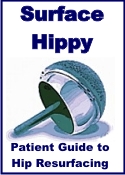Two-stage revision TKA shows good survival at 10 years
mean follow-up
March 2008
SAN FRANCISCO - Performing two-stage revision for infected primary total knee
arthroplasties shows good mid-term survivorship, according to a study presented
here.
Mirco Pietri, MD, and colleagues conducted a prospective study involving 121
patients who underwent two-stage revision for infected total knee arthroplasties
(TKAs) at a single center from 1991 to 2002. Pietri presented the results at the
American Academy of Orthopaedic Surgeons 75th Annual Meeting.
Most patients underwent primary TKA for osteoarthritis at a mean age of 70
years. Surgeons performed two-stage revision a median of 88 days after the
primary surgery, with most cases revised at least 4 weeks after the infection
was diagnosed and patients had failed other treatments.
Investigators lost 11 patients during an average follow-up of 9.8 years, Pietri
said.
The involved micro-organism was isolated in 108 patients and included 45
low-virulence and 63 high-virulence organisms. Of these, Staph. bacteria
accounted for more than 55% of all infections, he said.
Complete follow-up data were available for 85 patients at 5 years, and for 51
patients at 10 years.
Investigators found that both the mean WOMAC and Knee Society scores showed
significant improvements at 2 years and 5 years follow-up.
Sclerotic lines were noted around the tip of 24 tibial stems and 11 femoral
stems. Also, cortical reactions were reported in four cases at the tip of the
tibia.
“Progressive and complete radiolucencies seemed common, especially around the
tibias, but there were progressive lines around 7% of tibias and 6% of femurs.
Using the criteria of Barrack for stem loosening after total hip replacement, we
considered 7.5% of tibias probably or definitely loose and 3.5% of femurs
probably or definitely loose,” Pietri said.
Overall, there were 24 revisions, yielding a Kaplan-Meier survival rate of 75%
at 10 years when using revision for any reason as the end point, and a projected
survival of 69% at 15 years.
There were 14 revisions for mechanical reasons, yielding a Kaplan-Meier
survivorship of 83% at 10 years and a projected survival of 51% at 15 years, he
said.
Ten patients required revision for persistent infection. “This gave a cumulative
survival of 90% at 10 years and a projected [survival] of 86% at 15 years,” he
said.
“We also did a Kaplan-Meier survival analysis for the ‘worst case’ scenario:
Patients who were treated for persistent infection and under chronic antibiotic
suppression,” Pietri said. There was a total of 15 such cases, with a cumulative
survival of 85% at 10 years and 81% at 15 years, he said.
For the 10 patients who were revised for infection, the infection recurred after
a mean of 3.5 years. However, there were eight early secondary recurrences, with
six within the first year after revision and two recurrences from 5 years to 10
years.
A second two-stage revision was attempted in six patients, two of which were
successful. Knee fusion was attempted in four cases, with three cases achieving
success.
“In the remaining two [cases], we had one success, and the [last] patient did
not respond to any therapy and underwent above-the-knee amputation,” he said.
Reference:
Pietri M, Bourne RB, Rorabeck CH, et al. Two-stage revision TKR for infection.
Mid- to long-term results. Paper #444. Presented at the American Academy of
Orthopaedic Surgeons 75th Annual Meeting. March 5-9, 2008. San Francisco.
Knees for You Patient Guide to Knee Replacement -
Two-stage revision TKA shows good survival at 10 years mean follow-up
Related Articles
Latest Articles
- Computer Naviagated vs Conventional Study
- Diabetes does not increase risk of total knee surgical complications Study
- Rates of Knee Replacement and Revisions up in Last 20 Years
- Elderly patients show similar results as younger patients with mobile bearing UKA
- Vitamin D for Symptamotic Osteoarthritis Study
- MAKOplasty® Partial Knee Resurfacing Animation
- Oxford Unicompartmental Knee Replacement by Prof. Murry
- Two-stage revision TKA shows good survival at 10 years mean follow-up



